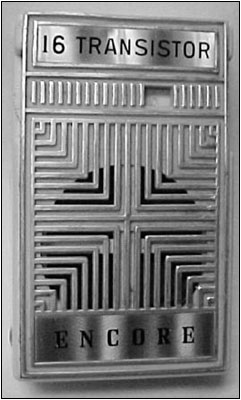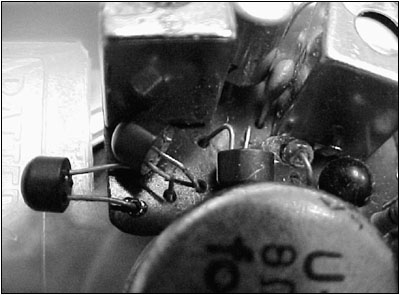Of Old Radios And Related Items--Published Monthly
Shirt-Pocket Transistor Radios
BY PHIL MacARTHUR
WEB EDITION
As in the 1930s, when radio manufacturers boosted tube counts for marketing reasons, some manufacturers of transistor radios followed suit. They added transistors that contributed little or nothing to a radio's performance. (Editor)
The transistor radio story began with the development of the Regency TR-1, a 4-transistor AM-only set that would fit in a shirt pocket. It was a joint project of Texas Instruments and IDEA, Inc., and hit the streets late in 1954. A few months later, Raytheon had its version in production, a larger, better sounding portable. Soon, the fabled Zenith 500 came along. By 1959, there were dozens of manufacturers in the game, producing everything from 1-transistor (toy or experimenter) radios to the legendary Zenith Trans-Oceanic Royal 1000, a 6-band, 9-transistor portable.
This chapter is about the relatively small "shirt-pocket" AM portables which made up the bulk of the transistor market. By the late 1960s, there had been scores of manufacturers cranking out hundreds of brand names with total production in the millions. Price competition was fierce.
These sets were first sold through established American radio and TV retailers with familiar names -- RCA, Zenith, Philco, Magnavox, Sylvania. Then Sony started the import wave, followed by a host of others. At first the foreign sets were sold under major U.S. trade names. Toshiba made for Penney, while Sharp made for Montgomery Ward. Then, they were marketed in every chain under every conceivable name, and who could count the explosion of importers from Japan, Korea, and Hong Kong, and finally, from the Philippines and Taiwan.
Why Extra Transistors?
Most often, shirt-pocket radios had six transistors. Some makers used five by eliminating the 2-transistor output in favor of a single device driving the speaker. Some others would make a 7-transistor set by adding an RF amp to improve sensitivity.

Figure 1. The Encore 16-transistor pocket radio.Some pricier sets would add an extra transistor for audio gain or bias control and the count would run up to eight or nine transistors. (Of course, there was the 2-transistor "boy's radio," but that's another story.) So far though, every transistor had a job. The competitive marketing pressure soon pushed the engineers to add transistors, which contributed little to the performance of a set.
The first additions were transistors hooked up in parallel to the output devices. This arrangement allowed the maker to brag of a 10- or 11-transistor set, quite often with verbiage about "power" or "high fidelity."
The next phase of escalation involved installing transistors with the collector leg clipped off, reducing it to a diode. These sets were marketed as 10-, 12- and 14-transistor sets, which, of course, worked no differently from their 6-transistor cousins. I have examples from Jade, Viscount, Encore and K-line with "transistorized diodes" all over the place.
The K-line is unique in that not only are 6 of the 14 transistors "gelded," but none of the devices have any markings on them whatever. The prize winner so far is the Encore 16, shown in Figure 1, which sadly has only 15 transistors, 9 of them neutered.
Tube and Transistor Races
This transistor escalation is all reminiscent of the tube race of the 1930s when some makers trotted out sets with an ever increasing number of tubes, most of which actually contributed something to the sensitivity or audio power. They even added to the total thermal output, as well as the appearance of the chassis.
I'm reminded of the time I bought a guitar amp from the late 1950s which had a tag on it advertising "4-tube power," only to discover that one tube, a 117Z3, had only the filament connected, and served no purpose at all.

Figure 2. Inside the Encore 16 showing some of the transistors that function as diodes.With the transistor race, however, no one ever got to admire those extras inside the plastic back. The cost to up the ante with a few extra transistors finally fell to around a nickel a piece, although I suspect the extras were rejects from Quality Control which added no cost at all.
The highest count transistor radios are usually the least collectible, and I continue to snatch 'em up at yard sales looking for an 18- or 20-transistor set with an ugly little secret waiting to be found.
(Phil MacArthur, 781 Spanish Main #71, Summerland Key, FL 33842)
Phil MacArthur is an electrical engineer from RIT in Rochester, NY, currently teaching mathematics at the Florida Keys Community College in Key West, FL. Email: keywestmac@cs.com
| [Free Sample] [Books, etc., For Sale] [Subscribe to A.R.C./Renew] [Classified Ads] [Auction Prices] [Event Calendar] [Links] [Home] [Issue Archives] [Book Reviews] [Subscription Information] [A.R.C. FAQ] URL = http://www.antiqueradio.com/Apr05_MacArthur_TransistorRadio.html Copyright © 1996-2005 by John V. Terrey - For personal use only. Last revised: March 27, 2005. For Customer Assistance please contact ARC@antiqueradio.com or call (866) 371-0512
Antique Radio Classified |